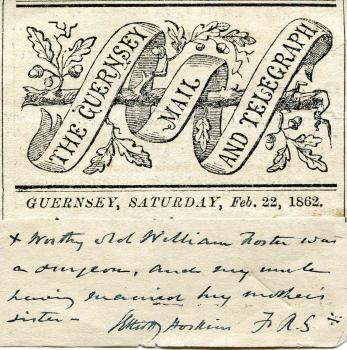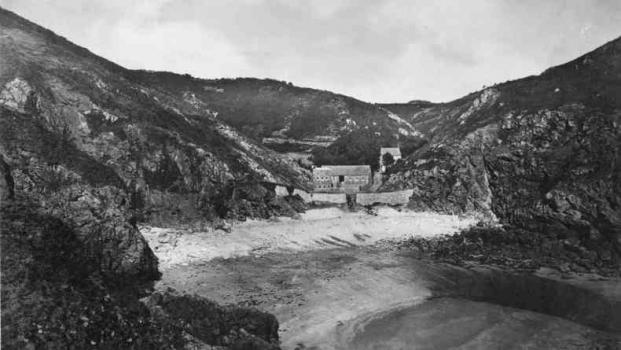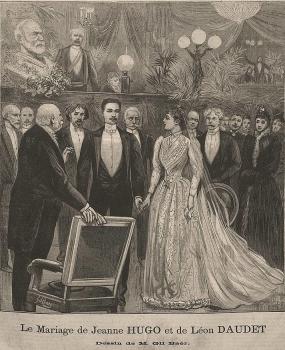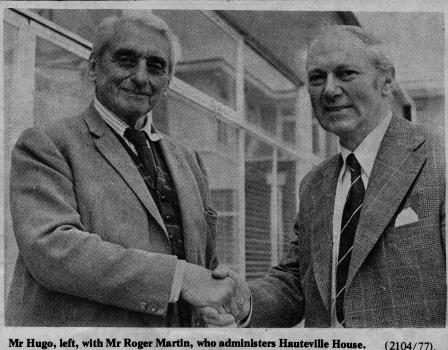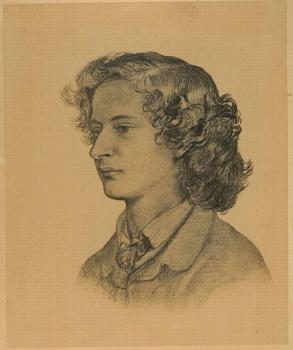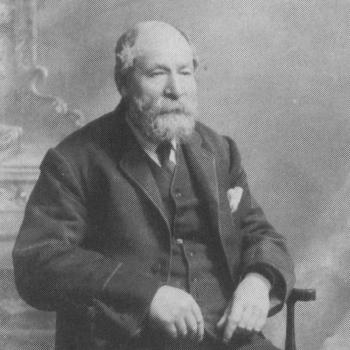7th May 2021
The Guernsey Mail and Telegraph, February 22, 1862. 'To the Editor of the Mail and Telegraph. As the following lines were the result of an hour’s innocently playful reminiscence, the Editor of the Mail and Telegraph might not be so terribly serious as to reject them. Small localities like this for every reflective mortal who has lived much through the seven ages of life, unavoidably furnish temptations to personal allusion. It is not the less true that, whether they be an FRS, a Sieur Pierre Robin, or an industrious and modest Charles Ozanne, not one of three acquaintances that LÔ DEBHAR* has presumed to notice here has ever inspired any other feelings than those of unfeigned respect and regard.' This is from a cutting in the Priaulx Library collection. The note above was made at the bottom of the cutting by Samuel Eliott Hoskins, FRS.
11th September 2020
By Herbert Bird Tourtel, from The Coming of Ragnarök, Guernsey, F B Guerin, 1895.
11th September 2020
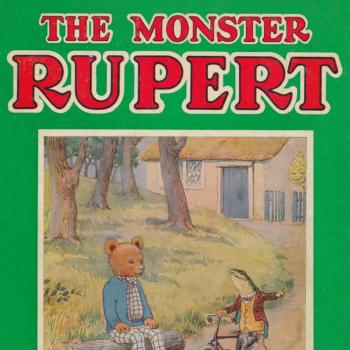
This November it will be 100 years since the first publication of a Rupert Bear story in the Daily Express newspaper. The intrepid little bear made his debut on November 8 1920; not a comic-strip, not a cartoon, but a ‘drawing’. Newsprint was short, and his creators were limited to one frame a day, either one large panel or a row of four small drawings. Occasionally the story was written in prose with a little marginal decoration. Rupert Bear was the invention of Mary Tourtel, a book illustrator, who worked on Rupert until he was handed over to Alfred Bestall in 1935. She was born Mary Caldwell in Canterbury, Kent, in 1874. Her father and brother were celebrated stained-glass artists and stonemasons who were associated with Canterbury Cathedral for many years, while another brother moved to South Africa, where he became a well-known painter of animals. Mary went to art school and became a professional illustrator, producing her first books in 1897. She died in 1948 and is buried with her husband in Canterbury. It is through her husband, Herbert Bird Tourtel, that Rupert Bear comes to be linked to Guernsey.
10th May 2019
Victor Hugo's granddaughter Jeanne (1869-1941) was the apple of his eye. She knew Guernsey well. She married a childhood friend, the controversial author Léon Daudet (1867-1942), who had plenty to say about Victor Hugo - very little of it complimentary. The marriage did not last long.By Dinah Bott.
3rd April 2019
Jean Hugo was the great-grandson of Victor Hugo. A talented artist and theatre designer, he was a schoolboy at Elizabeth College in Guernsey and made later visits to the island, of which he was very fond, including attending the inauguration of Jean Boucher's celebrated statue of the poet in 1914. The Library has a signed copy of his autobiography, Le Regard de la mémoire, which he gave to Roger Martin, the curator of Hauteville House at the time of his visit in 1977; Roger Martin's ancestor was, coincidentally, one of Victor Hugo's 'poor children.' The photograph is courtesy of the Guernsey Press.By Dinah Bott.
22nd March 2019
The poet Algernon Charles Swinburne visited Guernsey and Sark in order to follow in the footsteps of his hero and fellow poet, Victor Hugo. He fell in love with Sark and wrote poems describing his time there, so much so that he declared he would like to be king of the island. The portrait of a young Swinburne is by Rossetti — Swinburne had a mane of flaming red hair. It was drawn in August 1860 (image from the Rossetti Archive from a print held in the Delaware Art Museum). There is a selection of his Guernsey poems with reference to Victor Hugo at the bottom of this page. [By Dinah Bott]
8th March 2019
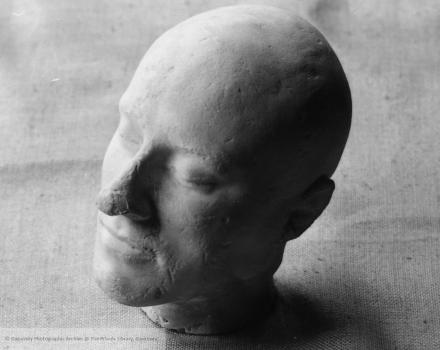
‘Tu ne tueras pas.’ Pas d’exception. ‘Thou shalt not kill.’ No exceptions. [Victor Hugo, 19 Feb. 1854, Marine Terrace, Jersey]. This death mask was kept by Victor Hugo in the Billiard Room in Hauteville House along with his famous drawing of Tapner, 'Le Pendu,' or 'The Hanged Man.' The Billiard Room was also home to portraits of the Hugo family, other favourite drawings, and maps of meaningful places in Hugo's life. The importance of these memoirs of Tapner to Hugo is thus obvious: they were a permanent reminder of the cruelty of man to man, and of his (for him) abject failure to save Tapner from the scaffold. In addition Hugo blamed himself for Tapner's execution, believing that his ardent intervention had actually been counter-productive - that the French government had pressed upon their British allies not to give in to Hugo's wishes, and that the British had complied. This striking photograph of the mask is by the late Guernsey photographer Carel Toms, taken in 1975, and is part of the Guernsey Photographic Archive held at the Priaulx Library.
12th April 2017
A lucky ticket, From the Gazette de Guernesey, 6 April 1822. A parody of a piece of puff for the Guernsey Lottery, the poem may be the work of Dr James Tupper - 'Monsieur Toupar' - who is known to have written light-hearted poems in Guernsey French.
23rd January 2017
October 1820. From a commonplace book in the Library, Flowers, from the Garden of Imagination. The compiler of the book is unknown, but there is a cipher on the flyleaf that appears to read 'FDC.' Another poem, To a Lady, is dated 'Guildford, August 2, 1817,' and has the legend, 'On her Friend's leaving Guildford for Ireland, where she is soon to join her.'
25th October 2016
In Guernsey in 1858 Victor Hugo became seriously ill with anthrax. It was apparently after recovering from this near-fatal illness that he was persuaded to grow a beard, as a protection for his throat; the first photograph of him sporting a beard was taken on 5 May 1861 on a visit to Brussels, during his trip to finish Les Misérables. For a while he allowed it to grow luxuriantly, but soon smartened it up and adopted the shorter beard now so familiar from photographs. Above is a portrait of one of Hugo's hairdressers, James Le Gallez, by kind permission of Ann Philippo. This is part of the Victor Hugo and Guernsey project. [By Dinah Bott]

